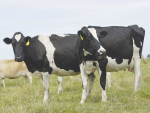If there’s a catch-all message from the dozens delivered during DairyNZ’s current series of ‘Spotlight on Cow Nutrition’ workshops, that’s it, judging by one held near Temuka last week.
“Many times the research isn’t drawn from New Zealand; many times that research is on a completely different system and that isn’t always made clear… Sometimes it’ll be material drawn from a feedlot system overseas and presented as if it’s applicable over here,” warned Lincoln University’s Jim Gibbs, senior lecturer in livestock health and production.
That’s important because the rumen function of a milking cow with a high intake of high quality pasture is quite different from that of a cow on a total mixed ration (TMR) or heavily supplemented pasture diet as is more common overseas, he says.
On a high quality, high intake grass diet, the rumen content doesn’t form the layers typically identified in overseas research, explains Gibbs, who has done groundbreaking research on the subject. “It’s just one mass of lawn clippings: there’s a little bit of fluid down the bottom [and] a very small gas cap – you couldn’t fit a hanky into it; basically it’s 120kg of lawn clippings rolling round and round inside.”
In addition, the cow is “eating” more than 100L of water in that grass, in some cases 150L, on top of what she drinks. “That changes the way the rumen functions; it changes the way things move through the rumen and stay in the rumen. It also changes the way they excrete various metabolites.”
Consequently, cows on high quality pasture diets respond quite differently to tweaks in nutrition from those on TMRs or other diets typical overseas, he says.
Following that introduction, Gibbs, and fellow speakers DairyNZ principal scientist John Roche, and independent consulting nutritionist Terry Hughes, fielded dozens of questions put by members of the near 100 farmers and industry professionals present, slaying many common marketing mantras along the way.
Straw during lactation was the first supplement to go up in flames. All it does is fill the cow up, cutting production. The arguments that high quality ryegrass pastures don’t have enough fibre for normal rumen function just don’t wash, says Gibbs. “Wherever straw has been put to the test, that’s here in New Zealand, in Australia, in Europe – and hear me clearly on this, so there’s no ambiguity – they always test same. There’s no effect on rumen pH and production either stays static, or much more commonly is reduced.”
The typically lower rumen pH on high quality grass diets has been shown not to be a problem and all straw, which typically has an ME of 6-8MJ/kgDM, does is reduce energy intake. What’s more, because it sits in the rumen for up to 72 hours compared to about 18 hours for good grass, it reduces intake too.
“So even if you’re only allocating 1kg of straw/day, that can lead to 3kg of rumen space being taken up. Even the biggest of rumens only holds 14-15kg of material, so what you’re doing is diluting your high ME diet with a very low ME material for no benefit.”
Where straw has a benefit is for springers, winter feeding and possibly at drying off. It will bind faeces, but contrary to some nutritionists’ assertions that’s no benefit as there’s no problem with the watery faeces typical of cows on high quality grass – it’s simply the effect of the high water intake in feed.
The fact lactating cows tuck into straw is no indication it’s needed either, Hughes pointed out. “Basically if you offer them something dry that they can eat quickly and easily, they will have a crack at it. And it’s not until three or four days later that you’ve got any feedback on the consequences of them eating that straw.”
Gibbs said even with moderate grain intake there’s still no need for straw. “Under 5kg/day of grain on really high quality pasture there’s still no advantage to straw and even above that [grain intake] it’s ambiguous.”
Asked about grain feeding, Roche warned feed substitution is inevitable and argued if there’s enough pasture, there is no benefit to feeding such a high energy feed.
Hughes tempered that comment, saying grain-feeding farms simply need to be set up to allow for that substitution. “You can say I want to do this level of production; I’m going to put in these levels of supplement; I’m going to get this sort of substitution so my cows instead of eating 15kg a day [of pasture] will be eating 13kg so I’ll put on more cows so I’ll have another cow there to eat the pasture that the previous one hasn’t eaten… You can come up with very good systems that will utilise that feed well. If you don’t, that’s when the costs start to build up.”
That reminded Roche that supplements such as grain could be put to good use to prevent residual pasture covers from going too low during a summer dry. “It’s very useful at this time of year to pull our residuals up to 1500-1600. That’s where we can use substitution to our advantage because if we deck summer pastures down to 12-1300 rotation after rotation it will take them a month longer to come back in the autumn.
“That’s the thing about it: supplement should be used to manage pasture, not to feed cows. If you use them to manage pasture you can make a lot of money out of feeding supplements,” he says.


















